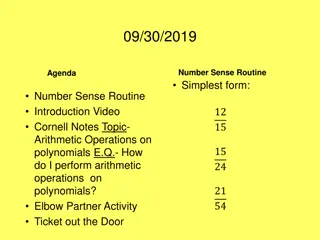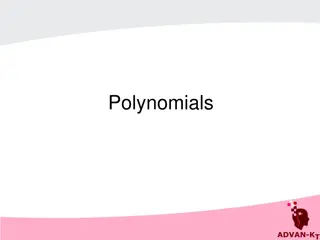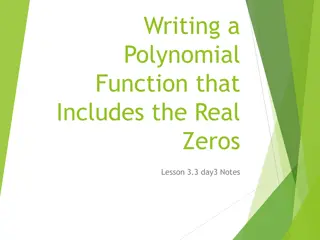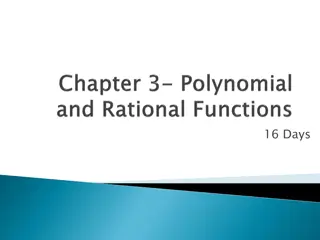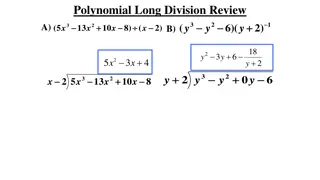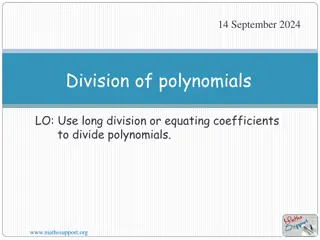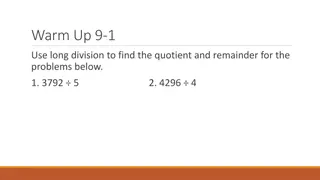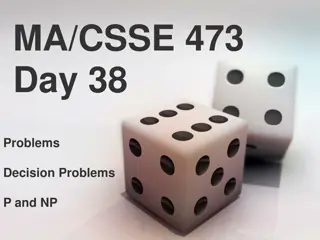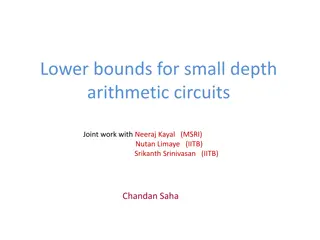Polynomial Basics: Definitions, Classification, and Operations
Learn the fundamentals of polynomials, including defining polynomials, determining degrees, classifying by terms, writing in standard form, and performing operations like multiplication and division. Understand monomials, binomials, trinomials, coefficients, and degrees of polynomials in a straightforward manner.
Download Presentation

Please find below an Image/Link to download the presentation.
The content on the website is provided AS IS for your information and personal use only. It may not be sold, licensed, or shared on other websites without obtaining consent from the author.If you encounter any issues during the download, it is possible that the publisher has removed the file from their server.
You are allowed to download the files provided on this website for personal or commercial use, subject to the condition that they are used lawfully. All files are the property of their respective owners.
The content on the website is provided AS IS for your information and personal use only. It may not be sold, licensed, or shared on other websites without obtaining consent from the author.
E N D
Presentation Transcript
Objectives Objectives After completion of this chapter, Students will be able to: 1. Define a polynomial 2. Determine the degree of a polynomial. 3. Classify a polynomial. 4. Write a polynomial in standard form. 5. Multiply polynomials. 6. Divide polynomials.
Vocabulary Monomial: A number, a variable or the product of a number and one or more variables. Binomial: A polynomial with exactly two unlike terms. Trinomial: A polynomial with exactly three unlike terms. Coefficient: A numerical factor in a term of an algebraic expression.
Vocabulary Degree of a monomial: The sum of the exponents of all of the variables in the monomial. Degree of a polynomial in one variable: The largest exponent of that variable. Standard form: When the terms of a polynomial are arranged from the largest exponent to the smallest exponent in decreasing order.
A polynomial is a monomial or the sum of monomials 2 4x 8 3 x Each monomial in a polynomial is a term of the polynomial. + x 2 3 5 2 14 x The number factor of a term is called the coefficient. The coefficient of the first term in a polynomial is the lead coefficient. A polynomial with two unlike terms is called a binomial. A polynomial with three unlike terms is called a trinomial.
The degree of a polynomial in one variable is the largest exponent of that variable. 2 A constant has no variable. It is a 0 degree polynomial. 4 + x 1 This is a 1st degree polynomial. 1st degree polynomials are linear. + x This is a 2nd degree polynomial. 2nd degree polynomials are quadratic. 2 5 2 14 x 3 3 8 x This is a 3rd degree polynomial. 3rd degree polynomials are cubic.
Example Classify the polynomials by degree and number of terms. Classify by number of terms Classify by degree Polynomial 5 Degree a. Zero Constant Monomial 2 x 4 b. First Linear Binomial x + 2 3 x c. Second Quadratic Binomial x + 3 2 Trinomial 4 1 x Third Cubic d.
To rewrite a polynomial in standard form, rearrange the terms of the polynomial starting with the largest degree term and ending with the lowest degree term. The leading coefficient, the coefficient of the first term in a polynomial written in standard form, should be positive.
Examples Write the polynomials in standard form. + 4 2 5 4 7 x x x + + 3 4 2 2 7 5 5 x x x x + + 4 3 2 + 2x 5x x 5 7 x 4 2 + 4x x 5 7 x Remember: The lead coefficient should be positive in standard form. ( 1 + + + ) 7 4 3 2 2 5 5 x x x x To do this, multiply the polynomial by 1 using the distributive property. 4 3 2 + 2x 5x x 5 7 x
Practice Write the polynomials in standard form and identify the polynomial by degree and number of terms. x 3 2 7 3 2 x 1. + 2+ 1 3 2 x x 2.
x 3 2 7 3 2 x x 3 2 7 3 2 x ( + 3 2 3x 2x 7 ) 7 + 3 2 1 3 2 x x + x 3 2 3 2 7 x This is a 3rd degree, or cubic, trinomial.
+ 2+ 1 3 2 x x + 2+ 1 3 2 x x + + 2 3x 1 2 x This is a 2nd degree, or quadratic, trinomial.
There are three techniques you can use for multiplying polynomials. It s all about how you write it Here they are! 1)Distributive Property 2)FOIL 3)Box Method Sit back, relax (but make sure to write this down), and I ll show ya!
1) Multiply. (2x + 3)(5x + 8) Using the distributive property, multiply 2x(5x + 8) + 3(5x + 8). 10x2 + 16x + 15x + 24 Combine like terms. 10x2 + 31x + 24 A shortcut of the distributive property is called the FOIL method.
The FOIL method is ONLY used when you multiply 2 binomials. It is an acronym and tells you which terms to multiply. 2) Use the FOIL method to multiply the following binomials: (y + 3)(y + 7).
(y + 3)(y + 7). F tells you to multiply the FIRST terms of each binomial. y2
(y + 3)(y + 7). O tells you to multiply the OUTER terms of each binomial. y2+7y
(y + 3)(y + 7). I tells you to multiply the INNER terms of each binomial. y2 + 7y +3y
(y + 3)(y + 7). L tells you to multiply the LAST terms of each binomial. y2 + 7y + 3y + 21
Remember, FOIL reminds you to multiply the: First terms Outer terms Inner terms Last terms
The third method is the Box Method. This method works for every problem! Here s how you do it. Multiply (3x 5)(5x + 2) 3x -5 Draw a box. Write a polynomial on the top and side of a box. It does not matter which goes where. 5x This will be modeled in the next problem along with FOIL. +2
3) Multiply (3x - 5)(5x + 2) 15?2 +6x -25x -10 First terms: Outer terms: Inner terms: Last terms: Combine like terms. 15x2 - 19x 10 3x -5 -25x 5x 15?2 -10 +6x +2
4) Multiply (7p - 2)(3p - 4) 21p2 -28p -6p +8 First terms: Outer terms: Inner terms: Last terms: Combine like terms. 21p2 34p + 8 7p -2 -6p 3p 21?2 -28p +8 -4
5) Multiply (2x - 5)(x2 - 5x + 4) You cannot use FOIL because BOTH are not binomials. You must use the distributive property. 2x(x2 - 5x + 4) - 5(x2 - 5x + 4) 2x3 - 10x2 + 8x - 5x2 + 25x - 20 Group and combine like terms. 2x3 - 10x2 - 5x2 + 8x + 25x - 20 2x3 - 15x2 + 33x - 20
5) Multiply (2x - 5)(x2 - 5x + 4) You cannot use FOIL because they are not BOTH binomials. You must use the distributive property or box method. x2 2x3 -5x +4 +8x -10x2 2x -20 +25x -5x2 -5 Almost done! Go to the next slide!
5) Multiply (2x - 5)(x2 - 5x + 4) Combine like terms! x2 -5x +4 -10x2 2x3 +8x 2x +25x -5x2 -20 -5 2x3 15x2 + 33x - 20
Dividing Polynomials 1. Be able to divide monomial with monomial. 2. Be able to divide monomial and binomial with multinomial 3. Be able to determine the factor of the polynomial.
Long Division of Polynomials Arrange the terms of both the dividend and the divisor in descending powers of any variable. Divide the first term in the dividend by the first term in the divisor. The result is the first term of the quotient. Multiply every term in the divisor by the first term in the quotient. Write the resulting product beneath the dividend with like terms lined up. Subtract the product from the dividend. Bring down the next term in the original dividend and write it next to the remainder to form a new dividend. Use this new expression as the dividend and repeat this process until the remainder can no longer be divided. This will occur when the degree of the remainder (the highest exponent on a variable in the remainder) is less than the degree of the divisor.
Text Example Divide 4 5x x2 + 6x3 by 3x 2. Solution We begin by writing the divisor and dividend in descending powers of x. Next, we consider how many times 3x divides into 6x3. Multiply. Divide: 6x3/3x = 2x2. 2x2 3x 2 6x3 x2 5x + 4 6x3 4x2 3x2 Multiply: 2x2(3x 2) = 6x3 4x2. Subtract 6x3 4x2 from 6x3 x2 and bring down 5x. 5x Now we divide 3x2 by 3x to obtain x, multiply x and the divisor, and subtract. Multiply. Divide: 3x2/3x = x. 2x2 + x 3x 2 6x3 x2 5x + 4 6x3 4x2 3x2 5x 3x2 2x Multiply: x(3x 2) = 3x2 2x. Subtract 3x2 2x from 3x2 5x and bring down 4. -3x + 4
Text Example contd. Divide 4 5x x2 + 6x3 by 3x 2. Solution Now we divide 3x by 3x to obtain 1, multiply 1 and the divisor, and subtract. Multiply. 2x2 + x 1 Divide: -3x/3x = -1. 3x 2 6x3 x2 5x + 4 6x3 4x2 3x2 5x 3x2 2x -3x -3x + 2 + 4 Multiply: -1(3x 2) = -3x + 2. Subtract -3x + 2 from -3x + 4, leaving a remainder of 2. 2
The Division Algorithm If f (x) and d(x) are polynomials, with d(x) = 0, and the degree of d(x) is less than or equal to the degree of f (x), then there exist unique polynomials q(x) and r(x) such that f (x) = d(x) q(x) r(x). + Divisor Dividend Quotient Remainder The remainder, r(x), equals 0 or its is of degree less than the degree of d(x). If r(x) = 0, we say that d(x) divides evenly in to f (x) and that d(x) and q(x) are factors of f (x).
CLICK ON VIDEO SONG ON POLYNOMIAL




